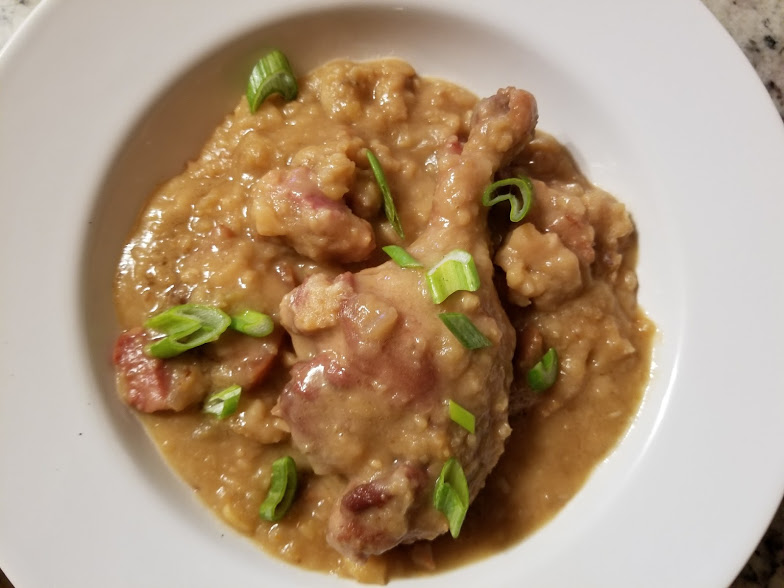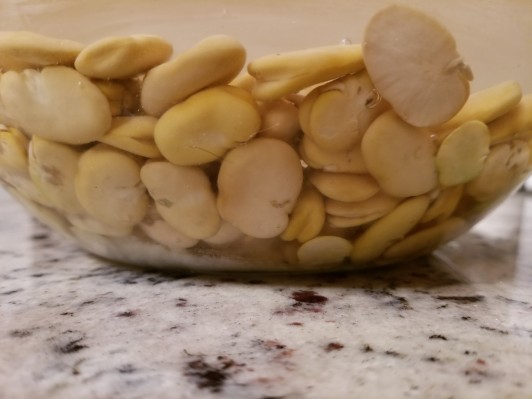Here is yet another invented Egyptian recipe (because the Egyptians left no recipes that we have found). Cassoulet is a much later french dish, variations on a peasant stew with salted meats and legumes. It’s very possible the Ancient Egyptians, of course loving both of those ingredients, would have eaten something similar.
This dish may appear simple, but it’s packed with the deepest flavor you can imagine. It’s hearty and filling too, and goes great with a loaf of Multi-grain Bread.
In early Egyptian history, the presence of meat makes this an elite dish. But wild water fowl like ducks could have occasionally been caught by both rich or poor, and later on, especially during the New Kingdom, pork became more affordable to those not of the upper crust.
Finally, Egyptians grew old world broad beans, particularly a variety called a lupine, which required soaking for several days to make non-toxic. We’re going to substitute Fava Beans, which are indigenous to North Africa.
That gives us the 3 main ingredients we need to make this all day stew. Duck, Salt Potk, and Fava Beans. Let’s make Egyptian Cassoulet.
EGYPTIAN CASSOULET
1 whole duck or substitute chicken (feet included if possible)
8oz Salted Pork Belly (Salt Pork)
1 lb. Dry Fava Beans.
1 onion, diced
1 carrot, split in half
1 turnip, split in half
Spring Onions or Scallions for garnishing
This dish takes all day to make, and you have to cover the Fava Beans in water and soak them the night before. The next day, make sure to drain and thoroughly rinse them.
You can either butcher your meats and make the duck stock the night before, or the morning of. Cut the salt pork into 1 inch cubes, and butcher the duck like you would a chicken. Save the breasts for another meal; they’re wasted in cassoulet. What you want to remove for this dish are the legs, thighs, and wings.
But don’t throw that carcass away! Throw it in a big pot instead, and cover with about 3 qts of water, bringing it to a boil then immediately turning it down to simmer for two hours. You just made duck stock.
If you can get a bird carcass with feet and head still on, your stock will be that much richer in texture and flavor later on.
Strain the stock through a mesh strainer and let cool a bit. Preheat your oven to 300F. Now it’s time to brown the meats.
In a dutch oven, put the salt pork in cold and turn the heat to an aggressive medium. Stir occasionally as the fat renders out for 8-10 minutes, until nice and brown and so deliciously salty.
Now, as a professional chef, what I’m about to tell you next pains me. Do not salt the Duck legs and wings. Seriously. It’s almost sacrilegious to brown meat unseasoned, but that salt pork is SO salty that anything extra is going to make the final dish inedible.
Remove the salt pork to a plate. Add the bird pieces to the pork fat and cook without disturbing it for about 6-8 minutes, until a nice brown crust has formed. Turn over and cook an additional 3 minutes on the other side. Remove to the plate.
Now you add your diced onion, sauteeing in the pork fat until the edges are cooked and things are sizzling, about 5 minutes. Add your fava beans and veg and 1 quart of the homemade duck stock. Bring to a simmer and cook for 20 minutes, until beans are getting nearly cooked but still raw in the center.
Add the salt pork and duck parts back to the pot, using them to submerge the beans. Put it in the oven.
Let cook in the oven for 4-5 hours, adding water as necessary to keep the beans submerged (though you may not need any). A nice crust will form. Remove the veggies, and mix together. Many of the beans will crumble apart. That’s okay (and also creamy and delicious).
Serve simply, garnishing with onion as the Egyptians loved to do.


















